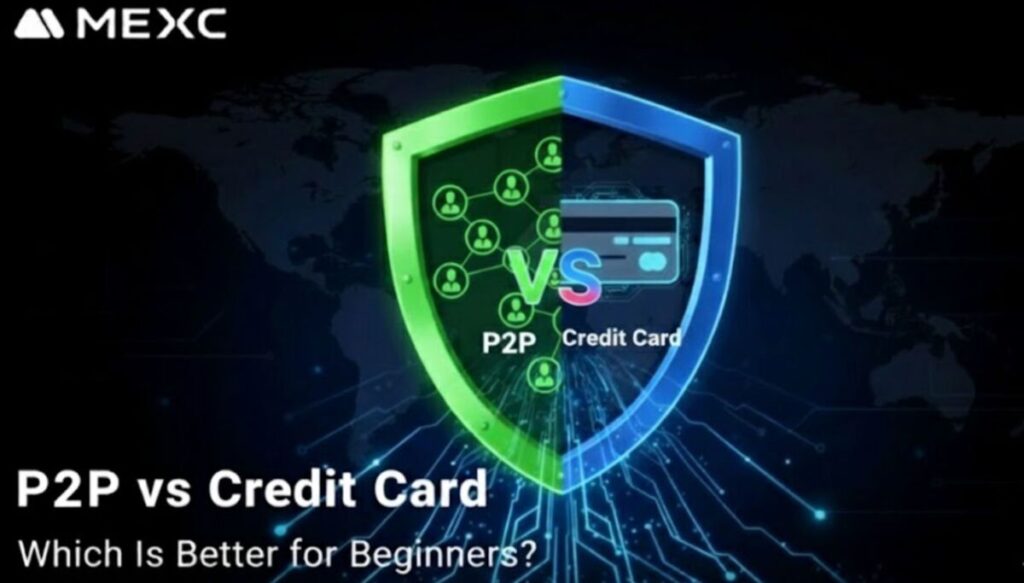
As you embark on your cryptocurrency journey in 2025 and beyond, one of the first decisions you’ll face is how to purchase your crypto. Whether you’re looking to buy Bitcoin, Ethereum, or another altcoin, the method you choose for buying your first crypto can make a significant difference in terms of cost, convenience, and security. For beginners, two popular options stand out: Peer-to-Peer (P2P) Trading and Credit/Debit Card Purchases.
This MEXC guide aims to help you understand the differences between these methods, focusing on ease of use, costs, security, and the best choice for beginners. Whether you’re looking for the quickest route to crypto or aiming to minimize fees, here’s a comprehensive breakdown to help you decide.
Method 1: Buying Crypto with a Credit/Debit Card
Buying crypto with a credit or debit card is one of the most familiar and straightforward methods for beginners. It’s similar to any other online shopping experience, making it an easy and quick way to dive into crypto.
How It Works
To buy crypto with a card, you simply link your Visa or Mastercard (or other payment methods like Google Pay and Apple Pay in certain regions) to a trusted exchange like MEXC. Once your card is linked, you can select the amount of crypto you wish to purchase, and the third-party payment processor facilitates the fiat-to-crypto transfer. Within minutes, the crypto is deposited into your exchange wallet.
Learn more: How to Buy Crypto with Credit/Debit Card on MEXC.
Pros and Cons
| Pros (The Good) | Cons (The Drawbacks) |
| Speed: Transactions are usually instant or take only a few minutes, perfect for fast purchases. | High Fees: This is the most expensive option. You pay a fee to the third-party processor and possibly a cash advance fee from your bank. |
| Convenience: As simple as typing in your card number and clicking “Pay.” | Bank Restrictions: Some banks block crypto purchases or charge very high cash advance fees. |
| Simplicity: The interface is easy and requires little interaction. | Purchase Limits: Daily or monthly limits may apply, restricting larger buys. |
| Global Availability: Card payments are supported in over 38 countries, making it widely accessible. | Possible Declines: Some banks may automatically flag or block crypto purchases, causing delays or cancellations. |
Additional Considerations
While credit cards are undeniably convenient, they come with some significant drawbacks. Users often face high fees, which include a processing fee from the payment provider (usually around 2%) and additional charges from the bank (such as cash advance fees). Some users also encounter bank restrictions where their banks block crypto purchases outright or impose high transaction limits. In countries like India, many banks restrict crypto transactions, making credit card purchases unreliable for users in such regions.
Furthermore, card transactions might be treated as cash advances, which attract high-interest rates from your bank. This can make your seemingly small crypto purchase far more expensive, especially if you fail to pay off the balance immediately.
Method 2: Peer-to-Peer (P2P) Trading
P2P trading provides a decentralized and cost-effective method of purchasing crypto directly from another user. This method is gaining popularity due to its zero fees, greater flexibility, and security features that are particularly attractive to beginners.
How It Works
P2P tradingenables you to buy and sell cryptocurrencies directly from other users (peers) on a platform like MEXC. The exchange platform acts as an intermediary by holding the seller’s crypto in escrow until both parties confirm that the payment has been made. Here’s the step-by-step process:
- Select a Seller: You browse through available offers from sellers who are willing to sell the cryptocurrency you want (e.g., Bitcoin, USDT).
- Choose Payment Method: P2P platforms like MEXC offer a wide variety of local payment methods such as bank transfer, PayPal, and Google Pay, giving you flexibility.
- Escrow System: The crypto is held in escrow by the exchange until the seller confirms that they’ve received payment.
- Transfer Payment: You send the fiat (e.g., USD, EUR) to the seller through your chosen payment method.
- Finalization: Once the seller confirms receipt of the fiat, the exchange releases the crypto from escrow to your wallet.
Pros and Cons
| Pros (The Good) | Cons (The Drawbacks) |
| Zero Fees: Platforms like MEXC offer 0% transaction fees, making this the most cost-effective option for beginners. | Slightly Slower: Transactions can take anywhere from 5 to 30 minutes, depending on the seller and payment method. |
| Payment Flexibility: Choose from hundreds of local payment methods, such as bank transfers, PayPal, and mobile wallets. | More Steps Involved: Requires you to initiate a separate payment to the seller, and wait for their confirmation. |
| Better Rates: Since sellers compete with each other, they often offer better rates compared to third-party processors. | Buyer Diligence: It’s important to verify a seller’s trade history, feedback, and reliability to avoid scams. |
| Escrow Protection: The exchange holds the crypto in escrow until the transaction is verified, ensuring security. | Potential Buyer Risk: Despite escrow protection, there’s a risk of fraud if you don’t carefully vet sellers. |
Why P2P is Great for Beginners
P2P trading offers several unique advantages, especially for beginners looking to minimize transaction costs. The zero transaction fees and flexible payment options make it a highly attractive method. It’s particularly advantageous for users in regions where banks impose high fees for international transfers or where local currency inflation is a concern. For example, in Argentina, Nigeria, and Kenya, users are increasingly turning to P2P platforms to convert their volatile fiat currencies into stablecoins like USDT to preserve their wealth.
P2P platforms also provide greater privacy than credit card transactions, as there’s no need to provide sensitive card details to third parties. The escrow system used by platforms like MEXC further enhances security by ensuring that the seller only receives the crypto once the buyer’s payment is confirmed.
Quick Comparison: P2P vs Credit Card
| Feature | Credit/Debit Card Purchase | Peer-to-Peer (P2P) Trading |
| Best for | Beginners prioritizing speed and convenience. | Beginners prioritizing low fees and flexibility. |
| Transaction Fees | High (2% processor fee + possible bank fees). | Very Low/Zero (Often 0 fees on platforms like MEXC). |
| Speed | Instant (Usually within 5 minutes). | Fast (Usually 5-30 minutes, depending on the seller). |
| Security | High, but depends on the third-party processor. | High, secured by escrow. |
| Payment Methods | Limited (Visa/Mastercard, Google Pay, Apple Pay). | Extensive (bank transfer, mobile wallets, e-wallets). |
| Availability | Available in 38 countries; restrictions in some regions. | Global, especially useful in emerging markets. |
| Limits | Up to $5,000 per transaction, $10,000/day. | Flexible, no strict caps. |
| Pros | Convenient, fast, familiar payment method. | Cheapest option, more payment flexibility. |
| Cons | High fees, potential restrictions, limited payment options. | Requires more steps, some seller risk. |
Conclusion: Which Should You Choose?
Ultimately, the choice between P2P and credit card purchases depends on your specific needs and preferences as a beginner:
- Choose Credit/Debit Card if:
- You need crypto immediately and don’t mind paying a bit extra for convenience.
- You’re new to crypto and prefer a familiar method of payment that’s quick and straightforward.
- Choose P2P Trading if:
- You’re looking to save on fees, with zero transaction costs.
- You want to take advantage of flexible payment methods and local payment options.
- You don’t mind waiting a few extra minutes for the transaction to complete and are looking for a more secure option with escrow protection.
For most beginners, P2P trading on a platform like MEXC is the better choice, especially for those looking to avoid high fees and enjoy more flexibility in payment methods. The escrow system also adds an extra layer of security, making it a safer and more cost-effective option for new crypto users.
Ready to make your first purchase?
Explore both methods and get started today: Buy Crypto via Fiat Deposit on MEXC.
Learn more about credit card purchases here: How to Buy Crypto with Credit/Debit Card on MEXC.
Or explore Google/Apple Pay: How to Buy Crypto via Google Pay and Apple Pay on MEXC.
Crypto is exciting—don’t let fees hold you back. Trade smart on MEXC!
Join MEXC and Get up to $10,000 Bonus!
Sign Up

